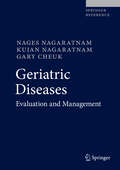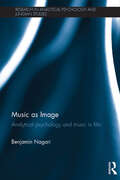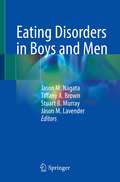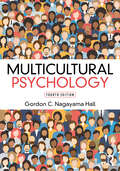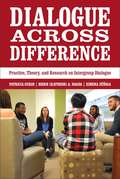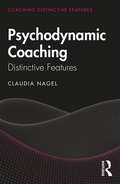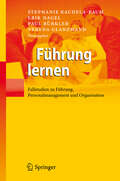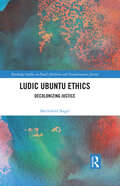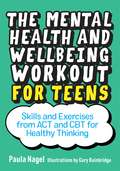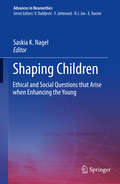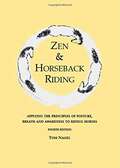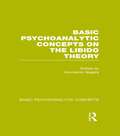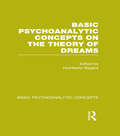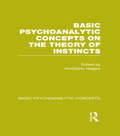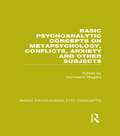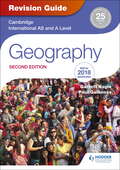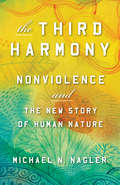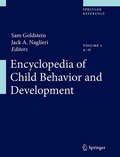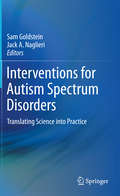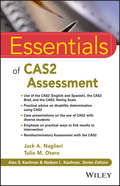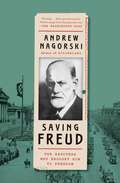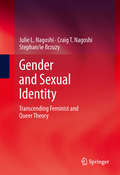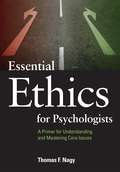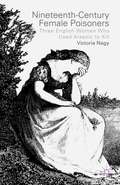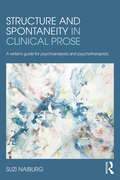- Table View
- List View
Geriatric Diseases: Evaluation And Management
by Nages Nagaratnam Kujan Nagaratnam Gary CheukThis volume provides a comprehensive overview of the unique clinical entities of diseases in older patients. The book arranges the organ systems in 21 sections, which include over 100 collective chapters on various age-related diseases in these organ systems. The text is specifically designed for ease-of-use and include learning tools that include multiple choice, short answer, and extended matching questions, case vignettes, self-assessments, and rich tables and illustrations. Each section includes a review of the anatomy, physiology and pathology that are specific to aging patients. The text covers the complex factors that present diagnosis challenges, including the interaction of the disease process with co-existing morbidities, aged- related physiological changes and pre-existing functional challenges and psychosocial circumstances. The text also works with the previously published text Diseases in the Elderly: Age-Related Changes and Pathophysiology, which is tailored to complement this resource.Written by experts in the field, Geriatric Diseases: Clinical Expression, Management and Impact is the ultimate guide on clinical expression and management of diseases in the elderly for medical students, residents, fellows, geriatricians, gerontologists, primary care physicians, internal medicine specialists, emergency room physicians, specialist nurses, and all other physicians and medical professionals treating older patients.
Music as Image: Analytical psychology and music in film (Research in Analytical Psychology and Jungian Studies)
by Benjamin NagariThrough a theoretical and practical exploration of Jungian and post-Jungian concepts surrounding image, this book moves beyond the visual scope of imagery to consider the presence and expression of music and sound, as well as how the psyche encounters expanded images – archetypal, personal or cultural – on both conscious and unconscious levels. By closely examining music in film, Nagari considers music’s complementary, enhancing, meaningful, and sometimes disruptive, contribution to expressive images. Chapters present a Jungian approach to music in film, highlighting how ‘music-image’ functions both independently and in conjunction with the visual image, and suggesting further directions in areas of research including music therapy and autism. Divided into three cumulative parts, Part I explores the Jungian psychological account of the music-image; Part II combines theory with practice in analysing how the auditory image works with the visual to create the ‘film as a whole’ experience; and Part III implements a specific understanding of three individual film cases of different genres, eras and styles as psychologically scrutinised ‘case histories’. Music as Image will be of interest to academics and students in the fields of applied psychoanalysis and Jungian psychology, music, film and cultural studies. With implications for music therapy and other art-based therapies, it will also be relevant for practising psychotherapists.
Eating Disorders in Boys and Men
by Jason M. Nagata Tiffany A. Brown Stuart B. Murray Jason M. LavenderBoys and men with eating disorders remain a population that is under-recognized and underserved within both research and clinical contexts. It has been well documented that boys and men with eating disorders often exhibit distinct clinical presentations with regard to core cognitive (e.g., body image) and behavioral (e.g., pathological exercise) symptoms. Such differences, along with the greater likelihood of muscularity-oriented disordered eating among boys and men, emphasize the importance of understanding and recognizing unique factors of clinical relevance within this population.This book reviews the most up-to-date research findings on eating disorders among boys and men, with an emphasis on clinically salient information across multiple domains. Five sections are included, with the first focused on a historical overview and the unique nature and prevalence of specific forms of eating disorder symptoms and body image concerns in boys and men. The second section details population-specific considerations for the diagnosis and assessment of eating disorders, body image concerns, and muscle dysmorphia in boys and men. The third section identifies unique concerns regarding medical complications and care in this population, including medical complications of appearance and performance-enhancing substances. The fourth section reviews current findings and considerations for eating disorder prevention and intervention for boys and men. The fifth section of the book focuses on specific populations (e.g., sexual minorities, gender minorities) and addresses sociocultural factors of particular relevance for eating disorders in boys and men (e.g., racial and ethnic considerations, cross-cultural considerations). The book then concludes with a concise overview of key takeaways and a focused summary of current evidence gaps and unanswered questions, as well as directions for future research. Written by experts in the field, Eating Disorders in Boys and Men is a comprehensive guide to an under-reported topic. It is an excellent resource for primary care physicians, adolescent medicine physicians, pediatricians, psychologists, clinical social workers, and any other professional conducting research with or providing clinical care for boys and men with eating disorders. It is also an excellent resource for students, residents, fellows, and trainees across various disciplines.
Multicultural Psychology: Third Edition
by Gordon C. Nagayama HallThe new edition of this bestselling textbook, Multicultural Psychology, helps students gain an understanding of how race, ethnicity, and culture shape their beliefs and behavior as well as those of people around them. Giving a voice to people underrepresented in psychology and society, this book introduces multicultural research in biological, developmental, social, and clinical psychology. The book reviews histories, gender roles, and LGBTQ intersectionality of African Americans, Latinx Americans, Asian Americans/Native Hawaiians/Pacific Islanders, Native Americans, Americans of Middle Eastern and North African heritage, and Americans with Multiple Racial/Ethnic Heritages to provide in-depth coverage of the largest groups of color in the United States. It provides the perfect balance of careful presentation of psychological concepts, research, and theories, and a sensitive, expertly rendered discussion of their applications to people of color. This book is ideal for a course on Multicultural Psychology and a must read for all psychology students as well as for everyone interested in multiculturalism. It is accompanied by a full, updated set of resources for students and lecturers. Content new to this edition includes: A chapter on Emerging Groups covering Americans of Middle Eastern and North African heritage, and Americans with Multiple Racial/Ethnic Heritages Up-to-date research on a rapidly growing multicultural literature Review of research on cultural responses to COVID-19 Coverage of White privilege and Whiteness Expanded coverage of qualitative research methods Recent neuroscience research on personally relevant interventions Expanded coverage of LGBTQ intersectionality A glossary Updated instructor and student resources, including PowerPoint lecture slides, video resources, and classroom exercises and activities
Dialogue Across Difference: Practice, Theory, and Research on Intergroup Dialogue
by Biren Ratnesh Nagda Patricia Gurin Ximena ZunigaDue to continuing immigration and increasing racial and ethnic inclusiveness, higher education institutions in the United States are likely to grow ever more diverse in the 21st century. This shift holds both promise and peril: Increased inter-ethnic contact could lead to a more fruitful learning environment that encourages collaboration. On the other hand, social identity and on-campus diversity remain hotly contested issues that often raise intergroup tensions and inhibit discussion. How can we help diverse students learn from each other and gain the competencies they will need in an increasingly multicultural America? Dialogue Across Difference synthesizes three years’ worth of research from an innovative field experiment focused on improving intergroup understanding, relationships and collaboration. The result is a fascinating study of the potential of intergroup dialogue to improve relations across race and gender. First developed in the late 1980s, intergroup dialogues bring together an equal number of students from two different groups – such as people of color and white people, or women and men – to share their perspectives and learn from each other. To test the possible impact of such courses and to develop a standard of best practice, the authors of Dialogue Across Difference incorporated various theories of social psychology, higher education, communication studies and social work to design and implement a uniform curriculum in nine universities across the country. Unlike most studies on intergroup dialogue, this project employed random assignment to enroll more than 1,450 students in experimental and control groups, including in 26 dialogue courses and control groups on race and gender each. Students admitted to the dialogue courses learned about racial and gender inequalities through readings, role-play activities and personal reflections. The authors tracked students’ progress using a mixed-method approach, including longitudinal surveys, content analyses of student papers, interviews of students, and videotapes of sessions. The results are heartening: Over the course of a term, students who participated in intergroup dialogues developed more insight into how members of other groups perceive the world. They also became more thoughtful about the structural underpinnings of inequality, increased their motivation to bridge differences and intergroup empathy, and placed a greater value on diversity and collaborative action. The authors also note that the effects of such courses were evident on nearly all measures. While students did report an initial increase in negative emotions – a possible indication of the difficulty of openly addressing race and gender – that effect was no longer present a year after the course. Overall, the results are remarkably consistent and point to an optimistic conclusion: intergroup dialogue is more than mere talk. It fosters productive communication about and across differences in the service of greater collaboration for equity and justice. Ambitious and timely, Dialogue Across Difference presents a persuasive practical, theoretical and empirical account of the benefits of intergroup dialogue. The data and research presented in this volume offer a useful model for improving relations among different groups not just in the college setting but in the United States as well.
Psychodynamic Coaching: Distinctive Features (Coaching Distinctive Features)
by Claudia NagelIn Psychodynamic Coaching: Distinctive Features, Claudia Nagel presents a comprehensive overview of the unique features of psychodynamic coaching. As leaders and managers acknowledge the need to understand themselves and their context by looking underneath the surface to improve their decision-making, psychodynamic approaches offer unique insight. Psychodynamic Coaching: Distinctive Features covers not only the major theory but also the practice of coaching, giving guidance from beginning to end of the client relationship. Constructive, holistic and accessible, it demonstrates the impact and dynamics of the unconscious whilst illustrating the power of understanding human behaviour in the complexity of the modern world. With a focus on emotions and relationships in supporting modern leaders adapting to organsational challenges, this book will be an invaluable tool for coaches of all backgrounds, academics and students of coaching and organisational behaviour, and also clinicians. It will also be a key resource for senior leaders for their own personal growth.
Führung lernen
by Erik Nagel Verena Glanzmann Paul Bürkler Stephanie Kaudela-BaumFür diese Fallstudiensammlung wurden 50 praxisrelevante, aktuelle und "typische" Fälle aus den Führungsetagen zu verschiedenen Themenfeldern der Personalführung aufbereitet. Im Vordergrund steht die Beschreibung alltäglicher Führungs- und Managementsituationen, d. h. konkreter Verhaltensweisen und Handlungsabfolgen von Führenden und Geführten in Non-Profit- sowie For-Profit-Organisationen. Kurzzusammenfassungen, Falleinstufungen, "Teaching Notes", Literaturempfehlungen und ein Stichwortverzeichnis verschaffen Dozierenden einen raschen Überblick.
Ludic Ubuntu Ethics: Decolonizing Justice (Routledge Studies in Penal Abolition and Transformative Justice)
by Mechthild NagelLudic Ubuntu Ethics develops a positive peace vision, taking a bold look at African and Indigenous justice practices and proposes new relational justice models. ‘Ubuntu’ signifies shared humanity, presenting us a sociocentric perspective of life that is immensely helpful in rethinking the relation of offender and victim. In this book, Nagel introduces a new theoretical liberation model—ludic Ubuntu ethics—to showcase five different justice conceptions through a psychosocial lens, allowing for a contrasting analysis of negative Ubuntu (eg., through shaming and separation) towards positive Ubuntu (eg., mediation, healing circles, and practices that no longer rely on punishment). Providing a novel perspective on penal abolitionism, the volume draws on precolonial (pre-carceral) Indigenous justice perspectives and Black feminism, using discourse analysis and a constructivist approach to justice theory. Nagel also introduces readers to a post secular turn by taking seriously the spiritual dimensions of healing from harm and highlighting the community’s response. Spanning disciplinary boundaries and aimed at readers seeking to understand how to move beyond reintegrative shaming and restorative justice theories, the volume will engage scholars of criminology, philosophy and law, and more specifically penal abolitionism, social ethics, peace studies, African studies, critical legal studies, and human rights. It will also be of great interest to practitioners and activists in restorative justice, mediation, social work, and performance studies.
The Mental Health and Wellbeing Workout for Teens: Skills and Exercises from ACT and CBT for Healthy Thinking
by Paula NagelThis easy-to-understand, engaging guide arms teens with healthy thinking habits and coping strategies for staying on top of their mental health. Using tried and tested therapeutic techniques, readers are given the tools to build their own personalised mental health 'workout' to boost their emotional resilience and wellbeing.Informed by the experiences of teens themselves, this friendly guide gives practical tips and strategies on how to overcome everyday stresses and ditch negative thinking 'frenemies' before they develop into more serious issues. Teens will be better equipped to recognise negative thoughts and emotions, monitor their mood and behaviour, and flex their positive thinking muscles in order to combat the mental health blips we all face sometimes.
Shaping Children: Ethical and Social Questions that Arise when Enhancing the Young (Advances in Neuroethics)
by Saskia K. NagelThe volume offers a unique collection of articles on pediatric neuroenhancement from an international and multidisciplinary perspective. In recent years, the topic of “neuroenhancement” has become increasingly relevant in academia and practice, as well as among the public. While autonomous adults are free to choose neuroenhancement, in children it presents its own ethical, social, legal, and developmental issues. A plethora of potential (neurotechnological) enhancement agents are on the market. While the manifold issues surrounding the topic have been extensively discussed, there is little work on the specific questions that arise in children and adolescents. This book addresses this gap in the literature: Next to conceptual and normative work on autonomy and self-control, the collection explores the implications for parenting and schooling, and provides input for a discussion of public attitudes. It is a valuable resource for the different academic communities confronted with questions of how to evaluate and approach enhancement in children and is of interest to neuroethicists, scholars in applied ethics and neurology, psychiatrists and psychologists as well as scientists developing enhancement interventions for children.
Zen And Horseback Riding: Applying The Principles Of Posture, Breath And Awareness To Riding Horses
by Tom Nagel Sally SwiftZen & Horseback Riding explains the location, importance and use of the psoas muscles. The psoas are the deep core muscles that link the upper and lower girdles of the body. They are the basis of all efficient body movement and can be used by everyone in any athletic activity. This book explains how to use your body to achieve tone, find self-carriage and to move correctly both on and off the horse. Zen & Horseback Riding is about using horseback riding as a means of self-development and training. It is about improving both your riding and your life. "synopsis" may belong to another edition of this title.
Basic Psychoanalytic Concepts on the Libido Theory (Basic Psychoanalytic Concepts)
by Humberto Nagera S. Baker A. Colonna E. First A. Gavshon A. Holder G. Jones E. Koch M. Laufer D. Meers L. Neurath K. ReesThe libido theory is one of the major areas of interest in psychoanalysis. Freud’s insights in this field have been widely applied and used by psychoanalysts, adult and child psychiatrists, psychologists, educationalists, experts on child development and social workers. They have thrown light on the normal and abnormal aspects of sexual development from childhood to adulthood and on the role played by sexual development in neurotic disturbances. Further they have made possible an understanding of the complex field of sexual perversions. Originally published in 1969, in this volume the reader will find twenty-four basic psychoanalytic concepts concerning the libido theory including oral erotism, anal erotism, phallic erotism, genital erotism, the Oedipus complex of the girl, the Oedipus complex of the boy, autoerotism, narcissism, masochism, sadism and bisexuality. As in the other volumes in this series, the historical development of each concept and references to Freud’s works are clearly given so that students and scholars can pursue any aspect of special interest.
Basic Psychoanalytic Concepts on the Theory of Dreams (Basic Psychoanalytic Concepts)
by Humberto Nagera S. Baker A. Colonna A. Holder D. Meers L. Neurath K. Rees L. Kearney R. Edgcumbe M. Kawenoka C. LeggIt is generally accepted that among Freud’s many contributions to the understanding of the normal and abnormal aspects of mental functioning, The Interpretation of Dreams stands alone and above all others. In this work published in 1900 Freud laid down the foundations of psychoanalytic theory as it was to develop throughout this century. This work not only unravelled the significance of the process of dreaming and allowed for the scientific understanding of the true meaning and nature of the mysterious world of dreams, but created the basis for a general theory of personality capable of encompassing within a single model both the normal and abnormal aspect of mental functioning. Originally published in 1969 Dr Nagera and his collaborators (all analytically trained) from the Hampstead Child Therapy Clinic and Course (now the Anna Freud Centre) isolated from Freud’s work twenty-five basic concepts that they considered not only the cornerstones of Freud’s theory of dreams but fundamental pillars for the understanding of psychoanalytic theory generally. They include subjects such as dream sources, dream work, dream censorship, manifest content, latent content, condensation, displacement, symbolism, secondary revision and dream interpretation. They are presented in a condensed and concentrated manner containing all significant statements made by Freud at any point in his life on the subject of dreams, as well as tracing the historical development of his ideas wherever significant. References to the sources are given in all instances for the guidance of the student of psychoanalysis, the psychiatrist, the social worker, the psychologist or the scholarly minded reader.
Basic Psychoanalytic Concepts on the Theory of Instincts (Basic Psychoanalytic Concepts)
by Humberto Nagera S. Baker R. Edgcumbe A. Holder M. Laufer D. Meers K. ReesOriginally published in 1970, this volume describes in condensed but detailed form Freud’s development of the theory of instincts. As is well known, Freud reformulated and amplified his theory of instincts at several points during his lifetime. Such periodical amplifications and reformulations were made necessary by a number of factors, for as Freud gained experience he not only developed fresh insights but also was faced with the problem of explaining an increasing amount of clinical phenomena that offered itself for examination under the psychoanalytic microscope. There can be no doubt that Freud considered his theory of instincts as one of the corner stones of psychoanalysis and yet at the same time he recognised that it was an area where many of his formulations were necessarily of a tentative character and open to discussion and modification. In this volume the reader will be able to follow the development of Freud’s thought from his initial discovery of the duality of ‘sexual’ and ‘ego’ instincts and his recognition of the fundamental importance of the aggressive forces in human nature and behaviour, to the formulation of his theories regarding life and death.
Basic Psychoanalytic Concepts on Metapsychology, Conflicts, Anxiety and Other Subjects (Basic Psychoanalytic Concepts)
by Humberto Nagera A. Colonna E. Dansky E. First A. Gavshon A. Holder L. Kearney P. RadfordOriginally published in 1970 and in contrast to the previous three volumes, which each dealt with a single subject, this volume is a miscellaneous one. Seventeen subjects were selected on the basis of their relevance for the understanding both of psychoanalytic theory and of human behaviour in general. In this volume the reader can follow the development of Freud’s theories regarding important subjects such as Fixation, Regression, Cathexis, Conflicts, Anxiety, Ambivalence, Reality Testing, Transference and Counter- Transference. Some of these subjects were chosen because of the many misconceptions and misunderstandings that surrounded them. As in previous volumes, the development of each concept is described from its conception to Freud’s final formulation and detailed references are given for the guidance of the student, the psychoanalyst, the psychiatrist, the social worker, the psychologist and the general reader.
Cambridge International AS/A Level Geography Revision Guide 2nd edition
by Garrett Nagle Paul GuinnessReinforce and practice skills learned with step-by-step support from experts to help you achieve your maximum potential.- Improve your knowledge of geographical patterns, processes and changes with internationally focussed examples and case studies from around the world.- Clarify key points and ensure common mistakes are avoided with expert advice and tips.- Test and consolidate your knowledge with end of topic questions and answers, and exam-style questions for AS and A2 levels.- Plan and pace your revision with the revision planner.
The Third Harmony: Nonviolence and the New Story of Human Nature
by Michael N Nagler , Ph.D.In the latest fruit of a brilliant career, Michael Nagler argues that nonviolence—not just as a tactic but as a way of being—is the only way to unite deeply divided people and enable progressive movements and leaders of all stripes to fulfil their promise and potential.So many of the problems that beset us—war, poverty, isolation, and the climate crisis—have their roots in an old story about the universe: we are purposeless matter in a random void, and scarcity, competition, and violence are inevitable. Citing the convergence of modern science and the essence of the world's wisdom traditions, Michael Nagler argues for a new story: the universe is conscious and purposeful, humans are spiritual beings, and cooperation and collaboration are our natural way of interacting. This "new story" has had other champions, but Nagler is the first to realize that a piece is missing. For the new story to take hold, we have to embrace nonviolence, not only as a social change tactic but as a way of life. Nonviolence is the only power strong enough to "move the heart" toward this deep and revolutionary change in worldview. Nagler refers to this as the "third harmony," which is the harmony within and among us to resolve the crisis of the human image. Calling on us to realize the urgency of nonviolence for resolving our personal and collective problems, Nagler focuses on how to shift to our story on a personal, everyday level and then integrate it into the very foundations of our understanding of humanity and community, for our sake, for the sake of future generations, and the sake of nonviolence itself.
Encyclopedia of Child Behavior and Development
by Jack A. Naglieri Sam GoldsteinThis major reference work breaks new ground as an electronic resource for students, educators, researchers, and professionals. Encyclopedic in breath, textbook in depth, Child Behavior and Development serves as a reference repository of knowledge in the field as well as a frequently updated conduit of new knowledge long before such information trickles down from research to standard textbooks. Presented in A to Z format, the Encyclopedia of Child Behavior and Development consists of three volumes that address the major conceptual areas of child development: learning, behavior, and emotions. Taking advantage of the techniques offered by the electronic medium, the Encyclopedia of Child Behavior and Development offers an extensive cross-referencing system that facilitates speedy search and retrieval of information.
Interventions for Autism Spectrum Disorders
by Jack A. Naglieri Sam GoldsteinChildren are being diagnosed with autism spectrum disorders at a staggering rate--as many as one in 110, according to some studies. To this sobering statistic add the familiar figures of the toddler disengaged from his peers, the middle schooler shunned in the lunchroom, and the adult struggling with social cues on the job, and professionals are faced with a mounting challenge: to assist and support young people with these disorders to ensure their successful transition to adolescence and adulthood. The first volume dedicated solely to its topic, Interventions for Autism Spectrum Disorders provides a comprehensive overview of programs currently in use. Contributors explore programs focusing on long-term outcomes, home- and classroom-based strategies, resilience training for parents, and pharmacological management of symptoms. Background chapters review issues in reliability and validity of interventions and evaluating treatment effectiveness. And an especially cogent chapter discusses the centrality of treatment integrity to best practice. Comprehensive programs and targeted interventions covered include: The Early Start Denver Model for young children.The TEACCH program for children, adults, and families.The Center for Autism and Related Disorders (CARD) and CARD eLearning.PROGress: a program for remediating and expanding social skills.Evidence-based strategies for repetitive behaviors and sensory issues.Self-regulation strategies for students with autism spectrum disorders.Interventions for Autism Spectrum Disorders is an essential resource for researchers, professionals/practitioners, and clinicians in a wide array of fields, including clinical child, school, and developmental psychology; child and adolescent psychiatry; education; rehabilitation medicine/therapy; social work; and pediatrics.
Essentials of CAS2 Assessment (Essentials of Psychological Assessment)
by Jack A. Naglieri Tulio M. OteroThe definitive guide to the latest edition of the Cognitive Assessment System Essentials of CAS2 Assessment is a comprehensive guide to the successful administration of the updated CAS2. Written by leading cognitive assessment experts, the book discusses the latest research and thinking on PASS (Planning, Attention-Arousal, Simultaneous and Successive) theory and includes case studies that demonstrate the use of CAS2 with several types of diagnostic groups and integration with other instruments. A companion website offers additional tools and information to help busy professionals make optimal use of the CAS2. This is the first book to provide comprehensive, step-by-step guidelines for administering, scoring, and interpreting the latest edition of the Cognitive Assessment System (CAS2). While the outcome of the test depends upon the child's performance, the reliability and accuracy of the analysis depends largely upon the performance of the test administrator. Essentials of CAS2 Assessment offers detailed insight on topics such as: Fair assessment of diverse populations Assessment of children with comorbid conditions Changes to the CAS2 rating scale and form Nuances of the three-tier model Each chapter in the book highlights key concepts, bulleted points, and actual test questions. The CAS2 is a valuable tool in the detection of learning disabilities, ADHD, TBI, retardation, and giftedness. Essentials of CAS2 Assessment is the guidebook professionals need to ensure the CAS2 test is applied and analyzed accurately so that the results can be applied to the maximum benefit of the child.
Saving Freud: The Rescuers Who Brought Him to Freedom
by Andrew NagorskiA dramatic true story about Sigmund Freud&’s last-minute escape to London following the German annexation of Austria and the group of friends who made it possible.In March 1938, German soldiers crossed the border into Austria and Hitler absorbed the country into the Third Reich. Anticipating these events, many Jews had fled Austria, but the most famous Austrian Jew remained in Vienna, where he had lived since early childhood. Sigmund Freud was eighty-one years old, ill with cancer, and still unconvinced that his life was in danger. But several prominent people close to Freud thought otherwise, and they began a coordinated effort to persuade Freud to leave his beloved Vienna and emigrate to England. The group included a Welsh physician, Napoleon&’s great-grandniece, an American ambassador, Freud&’s devoted youngest daughter Anna, and his personal doctor. Saving Freud is the story of how this remarkable collection of people finally succeeded in coaxing Freud, a man who seemingly knew the human mind better than anyone else, to emerge from his deep state of denial about the looming catastrophe, allowing them to extricate him and his family from Austria so that they could settle in London. There Freud would live out the remaining sixteen months of his life in freedom. This book is both an incisive new biography of Freud and a group biography of the extraordinary friends who saved Freud&’s life.
Gender and Sexual Identity
by Julie L. Nagoshi Craig T. Nagoshi Stephan Ie BrzuzyThe first comprehensive presentation of an explicitly transgender theory. This theory goes beyond feminist and queer theory by incorporating the idea of fluid embodiment and lived experience in conceptualizing gender and sexual identity. Beyond developing a formulation of transgender theory that incorporates the socially constructed, embodied, and self-constructed aspects of identity in the narrative of lived experiences, the authors discuss the implications of this "trans-identity theory" for theory, research, and practice.
Essential Ethics for Psychologists: A Primer for Understanding and Mastering Core Issues
by Thomas F. NagyThis introduction/review is intended for psychology students who have had minimal preparation in ethics or codes of professional conduct, and for psychologists who need a review. In addition to background, it presents ethical decision making models. The book begins by introducing the history and concepts of the APA Ethics Code, then treats four ethical concepts in depth: competence, informed consent, privacy and confidentiality, and avoiding harm and exploitation. These four concepts are then applied to specific roles such as psychological assessment, psychotherapy, research and publication, and ethics in teaching, training, and supervision. Case studies include fictional vignettes based on actual transgressions.
Nineteenth-Century Female Poisoners: Three English Women Who Used Arsenic to Kill
by V. NagyNineteenth-Century Female Poisoners investigates the Essex poisoning trials of 1846 to 1851 where three women were charged with using arsenic to kill children, their husbands and brothers. Using newspapers, archival sources (including petitions and witness depositions), and records from parliamentary debates, the focus is not on whether the women were guilty or innocent, but rather on what English society during this period made of their trials and what stereotypes and stock-stories were used to describe women who used arsenic to kill. All three women were initially presented as 'bad' women but as the book illustrates there was no clear consensus on what exactly constituted bad womanhood.
Structure and Spontaneity in Clinical Prose: A writer's guide for psychoanalysts and psychotherapists
by Suzi NaiburgStructure and Spontaneity in Clinical Prose will teach you to read gifted writers for inspiration and practical lessons in the craft of writing; apply the principles and techniques of the paradigmatic, narrative, lyric narrative, evocative, and enactive modes of clinical prose; and put what you learn immediately into practice in eighty-four writing exercises. Each of the five modes uses different means to construct worlds out of language. The paradigmatic abstracts ideas from experience to build concepts and theories. The narrative mode organizes experience through time, creating meaningful relationships between causes and effects. Lyric narratives present events unfolding in an uncertain present. The evocative mode works by invitation and suggestion, and the enactive mode creates an experience to be lived as well as thought. Structure and Spontaneity is fundamentally a book about reading and writing in new and different ways. It is an invaluable resource for new and experienced psychoanalysts and psychotherapists and for students, teachers, editors, and writers in the humanities and social sciences.
